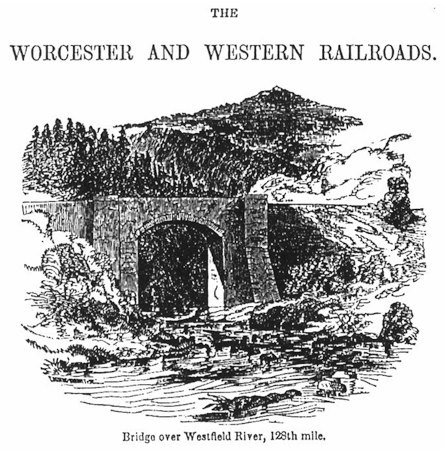
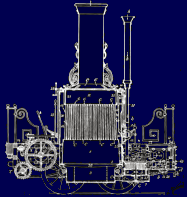
Whistler’s Wonders of the Westfield Branch
While the West Branch of the Westfield River is the only one without a dam, that is not to say there are no grand earth and stone structures. Indeed, in terms of structure, the West Branch “rules.” Along its length sit the first keystone arch railroad bridges built in America. They are wholly dry laid, range in height to 70 feet and made possible the longest and highest railroad in the world, the Western Railroad, in 1840.
The passage was ingeniously surveyed by Major George Washington Whistler; James McNeil Whistler’s father. So steep and remote it was said to be impossible, as ridiculous as a “railroad to the moon.” Yet not to try meant Boston would lose ever more traffic to New York as they had since the Erie Canal opened in 1823. The canal siphoned traffic down the Hudson River, but a railroad to Albany could recapture that trade.
Following the West Branch gave the railroad builders the lowest altitude crossing of the Berkshire Range (1458 ft.) The serpentine course of the river made constant bridging necessary. Stonemason Alexander Birnie of Stockbridge was brought in to construct 27 bridges, culverts and walls in the mountain section of the line. Most impressive of these edifices were ten keystone arch bridges over the winding Westfield.
The beauty of these structures has drawn visitors for decades, all trespassers on the property of various successor companies to the Western (now CSX). This dangerous practice was the only access until the recent completion of a hiking trail to two bridges abandoned in a 1912 line relocation. The trail and empty bridges are wholly on the property of the state Division of Fisheries and Wildlife.
While people have worked hard and are willing to hike a long way to experience these monuments, there is another way to see them, including those still carrying trains high above the river; in a kayak or a C-1. Cautions must be given that this is a re-mote area which, in fact, boasts the largest road-less tract in western Massachusetts. Rapids are a “good III to III plus” according to Jeff DeFeo, Whitewater Race organizer. He also says the river is uncontrolled and can rise suddenly or be too low to get through.
A trip down stream from the Bancroft section of Middlefield along Town Hill Rd., takes you along a wondrous Wild & Scenic stream with massive reminders of the Early Industrial Age. The thought may suggest desecration of wilderness but, on the contrary, these bridges, of local stone, have the ability to meld with, even enhance their surroundings, as well as change appearance with the seasons.
The Third Edition of the Appalachian Mountain Club “Classic Northeastern Whitewater Guide” describes an invigorating six mile trip with a 50 foot/mile and up to 100 foot/mile drop. While “rail-road bridges” are mentioned, it in no way prepares the rider for the awesome monuments they will encounter. They do allow that the scenery is “Excellent” and rate difficulty at III-IV.
Some new bridges were constructed with the line relocation, also of the arch design, only built with concrete rather than stone. This trip starts at a stone bridge, still carrying trains, then the twisting path leads successively under a concrete arch with trains, then two magnificent granite arches 70 and 65 feet overhead. These bridges were bypassed and now carry only hikers on the Keystone Arch Bridge Trail. Next is a concrete arch right beside a stone bridge, giving a tunnel effect. This is where the old and new lines diverge. Last is the only double arch bridge in the series. It is also in use by the railroad.
The story of the Keystone Arch Bridge Trail concerns local citizens who took action when progress with a $569,000 Interstate Surface Transportation Enhancement Act (ISTEA) grant disbursement came to a halt (where it remains). The Pioneer Valley Planning Commission had carried the trail planning to a point where there was a hard design for the pathway that could be implemented by volunteers. Ground was broken by an AmeriCorps crew in the summer of 2000. When school began that September, Dave Pierce of the Maintenance Dept. and Joseph Charnley, a teacher, both at Gateway Regional School District, hatched a plan to utilize Charnley’s Outdoor Activities Program (OAP) to continue the trail work during school vacations.
While the winter of 2000—2001 was a rough one, OAP was able to carry out all of the “above ground” work on the trail. This included the effort to cut and remove fallen trees, prune any branches in the treadway and the removal of trees in the trail. AmeriCorps returned in July of ’01, essentially completing the scratch-built portion of the trail. Other sections employ the abandoned roadbed and a portion of the ancient stagecoach road to Albany, the Pontoosic Turnpike.
Much remains to be done, however. There remains an abundance of brush, trees and rocks to be removed from other sections of the walkway. Presently, students in the Art and Metal departments at Gateway Regional High School are working on informational signs to be placed along the trail; this, with the help of a generous grant from the Hill town Coalition for Youth and Community Needs.
rg blue replica watchesThe Friends of the Keystone Arches was formed to coordinate efforts in this direction. They offer a trail map free of charge, but donations for the work are accepted and appreciated.
The map may be obtained by sending a large (#10 size) SASE to:
Friends of the Keystone Arches
P.0. Box 276
Huntington, MA 01050
Fascinating History!
The fascinating history behind the building of the Keystone Arches doesn’t get any better than this! The Western Railroad was the longest (150 miles) the steepest (1458 ft.) and the first (mountain climbing) railroad in the world. It included the longest bridge in the world, over the CT River, at Springfield, MA. Much of this was brought about by one of the most talented, yet un-remarked individuals in the annals of Civil Engineering; Maj. George Washington Whistler, father of famed painter, James Abbott McNeil Whistler.
Whistler was a West Point graduate from the class of 1819. After his first wife, Mary Smith, died very young, Whistler married Anna Matilda. Their son, the noted painter James McNeill Whistler, attended West Point without graduating.


1849


Arrangement in Grey and Black: Portrait of a Painter’s Mother”
Whistler spent his active army career as a topographical engineer. During the 1820s, when West Point graduates were virtually America’s only trained engineers, the government began lending their services to private companies. Whistler went to the Baltimore & Ohio Railroad. Other railroad and related engineering projects followed, before and after he resigned his commission in 1833. Whistler went to Russia in 1842 to supervise construction of the Moscow-St. Petersburg railroad, Also known as The Trans-Siberian Railroad.
Whistler employed Alex Bernie, a Scottish engineer to design and build the bridges. While Whistler has the most name recognition, he in fact, shared the title of Chief Engineer with Whistler’s uncle, William Gibbs McNeil. The two had collaborated on the Baltimore & Ohio R.R. earlier. Truth be known, McNeil was appointed Chief Engineer on 3/16/1836, with William Swift as Resident Engineer. On 5/8 of that year Whistler was brought on board to produce drawings for 6 10-ton and 4 14-ton locomotives and some passenger cars to go with them.
It was not until three years later, 5/19/39 upon the resignation of William Swift, that Whistler was appointed a Chief Engineer, in fact sharing that title from that point on with his brother in law, Mr. McNeil. This was the most difficult portion of the project, however, as rails reached Springfield on 10/1/39, commencing the crossing of the CT River and the torturous crossing of the Berkshire Range.
The basics of railroad engineering were developed here. Cut and fill, climb without losing any altitude. Why is this largely forgotten today? Within fifteen years the Mississippi had been crossed, in thirty, the Rockies were conquered. Both utilized lessons learned along the West Branch, they nevertheless made Whistler’s feats seemed insignificant by comparison. Ever larger accomplishments, like the size of the states, are illustrative of the broadening imaginations of the founding fathers as westward settlement proceeded.
Indeed, fifty years before the dawn of the railroad age, no less a thinker than Thomas Jefferson predicted it would take until the year 2000 for colonists to settle all the land available in the west. The only thing missing from his hypothesis? The railroad.
The Railroad

Pictured above is a Pacific-type locomotive, the largest type of engine that would have crossed the now abandoned arches.
Whistler spent his active army career as a topographical engineer. During the 1820s, when West Point graduates were virtually America’s only trained engineers, the government began lending their services to private companies. Whistler went to the Baltimore & Ohio Railroad. Other railroad and related engineering projects followed, before and after he resigned his commission in 1833. Whistler went to Russia in 1842 to supervise construction of the Moscow-St. Petersburg railroad, Also known as The Trans-Siberian Railroad.
Whistler employed Alex Bernie, a Scottish engineer to design and build the bridges. While Whistler has the most name recognition, he in fact, shared the title of Chief Engineer with Whistler’s uncle, William Gibbs McNeil. The two had collaborated on the Baltimore & Ohio R.R. earlier. Truth be known, McNeil was appointed Chief Engineer on 3/16/1836, with William Swift as Resident Engineer. On 5/8 of that year Whistler was brought on board to produce drawings for 6 10-ton and 4 14-ton locomotives and some passenger cars to go with them.
It was not until three years later, 5/19/39 upon the resignation of William Swift, that Whistler was appointed a Chief Engineer, in fact sharing that title from that point on with his brother in law, Mr. McNeil. This was the most difficult portion of the project, however, as rails reached Springfield on 10/1/39, commencing the crossing of the CT River and the torturous crossing of the Berkshire Range.
The basics of railroad engineering were developed here. Cut and fill, climb without losing any altitude. Why is this largely forgotten today? Within fifteen years the Mississippi had been crossed, in thirty, the Rockies were conquered. Both utilized lessons learned along the West Branch, they nevertheless made Whistler’s feats seemed insignificant by comparison. Ever larger accomplishments, like the size of the states, are illustrative of the broadening imaginations of the founding fathers as westward settlement proceeded.
Indeed, fifty years before the dawn of the railroad age, no less a thinker than Thomas Jefferson predicted it would take until the year 2000 for colonists to settle all the land available in the west. The only thing missing from his hypothesis? The railroad.
Some of the railroad emblems that have traveled these rails:
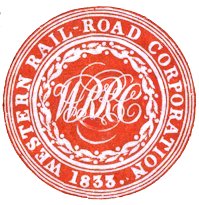



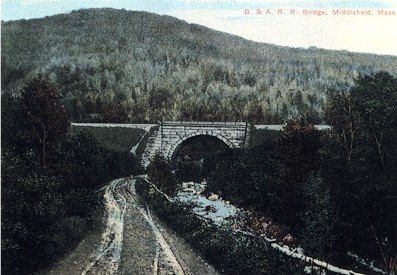
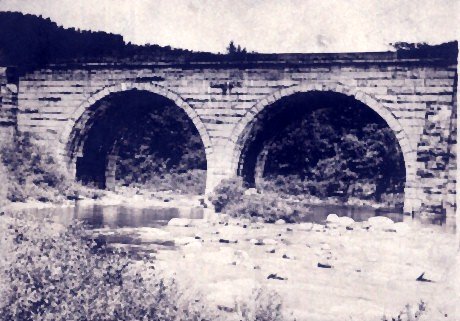
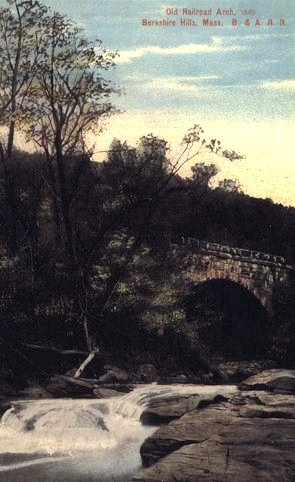
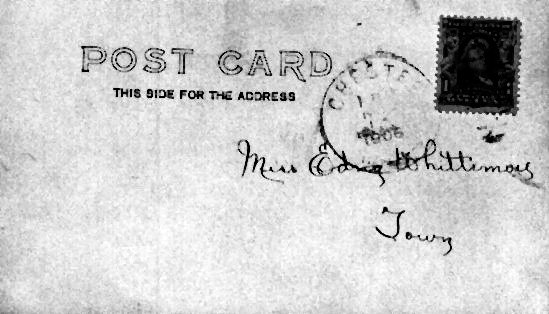
Drawings of the Arches from the 1800’s & early 1900’s:
